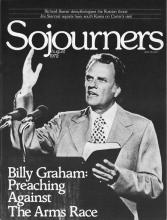"There were lots of fights and alcoholism back then. The police came to our street so much that we asked them, 'Why don't you just rent an apartment and stay?' I think God looked down on us and said, 'Hell is right there on Belmont Street.'"
For Rita Branham and the other residents of her block, there was little hope in the early 1970s. But, while they lived in the violence and deterioration of Washington, D.C.'s 14th Street "riot corridor," hope was brewing in a very different part of the city.
That place was the lunch room at the National Gallery of Art -- an unusual spot for a new ministry to Washington's poor to be born. There Tom Nees, pastor of the wealthy Washington First Church of the Nazarene, and John Lunsford, a criminal lawyer in the parish, held clandestine meetings.
They were fearful of the reaction that their denomination might have toward their vision of an alternative church. But they eventually "came out of the lunch room" and shared their thoughts with denomination leaders. They received overwhelming support.
Housing was the issue that Tom and John identified as most pressing. Speculation in many parts of the city was forcing low-income residents onto the streets.
Tom found encouragement in the words of the prophet Isaiah, who stated that the people of God would "raise up the former devastations and repair the ruined cities" (Isaiah 61:4). This was the vision that sustained him.
Tom and John joined Jubilee Housing, Inc., a mission group of Washington's Church of the Saviour. The group was pouring money and volunteer labor into housing renovation.
But a completely new model of housing which could be a viable alternative in a profit-motivated society was needed.
Read the Full Article

